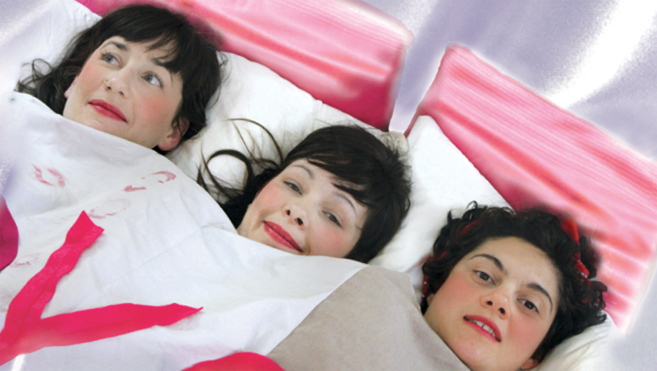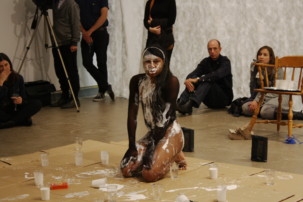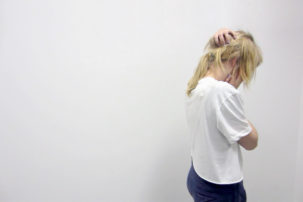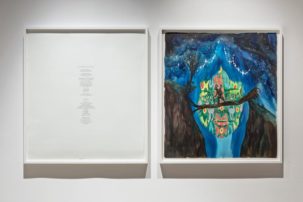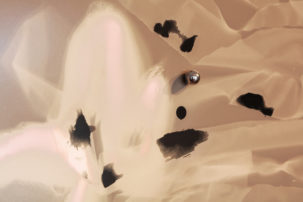This past March, it was wavering around zero degrees Celsius in Calgary—that particular type of dry cold that many in the city complain about—and Juan Ortiz-Apuy had an opening at Truck Contemporary. La Guaria Morada featured 13 tropical orchids suspended from the ceiling with aircraft cable. They were kept alive in the gallery by a configuration of small dehumidifiers and a giant ultrasonic industrial humidifier arranged on the floor, complete with long electrical cables looping and wiggling back to outlets in the walls. It was the largest version to date of a project the artist had previously installed at Gallery TPW, where I currently work, in an exhibition curated by Sam Cotter. At Truck, Ortiz-Apuy tells me, the entire space felt humid and tropical. The installation changed the gallery’s entire climate considerably, much to the pleasure of those coming in from the cold, dry Calgary air.
I remain invested in La Guaria Morada in a manner familiar to those of us who work in art galleries: I lived with the installation for over a month, and together we breathed the same air. Weekly, I and other TPW staff unhooked each orchid from its cable, carried it to the office sink, and watered it. Daily, we checked their roots for new growth, emptied the dehumidifier and refilled the humidifier tanks. These routines remain in my body long after each exhibition concludes, and I must slowly adjust my rhythms to what needs to be cared for next—waving remotes at projectors, dusting down frames, adjusting plinths and benches. Ortiz-Apuy’s installation is certainly a gesture to the invisible forms of labour and care that drive artist-run spaces: moving like cycles of evaporated water, infinitely extracted and re-released in the air. Yet much like the neutral gallery atmosphere suddenly turned thick, humid and palpable, La Guaria Morada calls attention to how conditioned air, in fact, conditions our work, our art objects, our ways of looking. At the most immediate level, air quality conditions experience.
This past January, it was well below freezing in Toronto—that especially bitter kind of cold that leaves many of us cranky and indoors—and Tegan Moore had an opening at Zalucky Contemporary. Alongside a number of her quiet, distinct sculptural works, she had produced something significantly larger. Metaducting was hardly noticeable at first, despite its size: the long reach of an existing gallery air-duct enclosure was extended and made to turn back toward itself, producing a clunky almost-spiral emerging from the blank white wall. Many visitors assumed it was an existing piece of the gallery’s architecture, or perhaps it didn’t register with them at all. Yet alongside Moore’s sculptural assemblages of ventilation filters, vapour barriers and eroded insulation, Metaducting quietly—and cheekily—implicated the gallery itself in a larger conversation about what it means to control our climates, specifically within an art space.
It’s not particularly groundbreaking to state that galleries are designed to feel totally neutral: the white-cube metaphor is often a reality when art spaces are structured with blank, featureless walls, consistent track lighting and as few architectural irregularities as possible. However, I often forget that gallery air is equally as fabricated—subject to the same choices and controls. Perhaps it is because air controls are too ubiquitous: so many of our interior public spaces are now heated, cooled, brought to equilibrium with a standardized, so-called “room temperature.” It feels almost as if interior air is inherently malleable, an entirely different substance from what gusts and flows outdoors. From ceiling fans and air ducts to full heating, ventilation and air conditioning (HVAC) systems, humidifiers, dehumidifiers—these are complex atmospheric infrastructures constructed, first, to keep bodies comfortable and, second, to be as unobtrusive as possible. This is what remains so charming about Moore’s Metaducting: it absurdly exaggerated an existing architectural feature of Zalucky Contemporary— disrupting the space’s otherwise planned blankness—yet it also completely receded from view. It’s an apt reminder that we remain deeply skilled at ignoring what is around us, what keeps us comfortable.
These atmospheres are never neutral. The ways we look at and think about art in public are never neutral.
Both inside and outside the gallery, it’s worth mentioning that the histories of climate control and mass spectatorship are deeply entwined. The modern air conditioner was first invented in 1902 to keep paper from warping in a New York printing house, but it wasn’t until 1925 that it made its public debut in the Rivoli Theatre in Times Square. Having struggled to retain business during the summer months, cinemas clamoured over the technology, and viewers soon began flocking indoors to watch movies and escape the heat. As a result, the whole landscape of Hollywood film began to shift; many sources credit the integration of air conditioning in movie theatres with the rise of the summer blockbuster. Bodies looking together in public spaces needed to be kept comfortable. The advantages—social, cultural, economic—were obvious. Air conditioning was foremost a marketing tool, only accessible if you could afford the cost of a ticket. Feeling cool indoors on a sweltering day is indeed luxurious. It’s remarkable how quickly a luxury can be justified as a seemingly neutral, necessary thing.
The advantages to climate control in galleries are obvious too: like Ortiz-Apuy’s orchids, artworks are vulnerable creatures. There is humidity that can warp and curl delicate paper, UV rays that discolour photographic prints, dust that settles on the surface of everything. Small fans are installed inside the projectors for video installations, designed to keep the equipment from overheating. But air conditioning also produces a comfortable context for spectatorship: like white-cube gallery walls, it’s a microclimate that promises to support sustained viewing and thinking. When you’re comfortable—when the very air you breathe validates your presence—you might feel nothing at all. You might forget you have a body entirely: just eyes that narrow in thought, just pensive intellect. There is a significant amount of labour and resources behind this nothing-feeling—and let’s be clear, it isn’t free. Nor do galleries (or any public spaces, for that matter) distribute these comforts evenly. Like Moore’s Metaducting conspicuously extending its reach, that’s when the cost of gallery air becomes visible, if you look carefully enough. It’s when an atmosphere becomes totally inhospitable to those communities deemed unwelcome or unworthy of spaces of culture. It’s when our air-conditioning units consume copious amounts of energy keeping our indoors cool, directly producing an exterior climate that’s increasingly, irrevocably damaged. On the global scale, these comforts are extremely, impossibly expensive.
It’s early May of this year, and the weather in Toronto is finally nearing 20 degrees Celsius—a warmth growing too slowly for those of us hungry for summer. As part of Laurie Kang’s exhibition “A Body Knots” at Gallery TPW, we were building a free-standing wall structure to support a series of nearly floor-to-ceiling, large-format photograms. In 2014, the gallery moved to its current location: an industrial building that previously operated as cold storage for a wholesale fish company born of Toronto’s Portuguese community. As we planned for Kang’s installation, it became obvious that we would need to drill into the concrete floor to secure the wall in place. What we hadn’t expected was the distinct fish smell, billowing up in clouds of concrete dust as we made each hole in the floor. As the fish dust settled, I wiped it away as best I could with a wet cloth. I still wonder how much of it is left on TPW’s floors, on Kang’s work, in my lungs and hair, circulating through the gallery’s HVAC system. How much of this history—of industry, distribution and consumption; of immigrant labour; of animal death and decay—is travelling across the city on the bodies of visitors, in random gusts of wind?
It’s now late June, and I have been writing this text amid Toronto’s first real bursts of summer heat—the kind of heat when your exposed skin starts to accumulate the gritty sediment of city air. I’ve been thinking so much about what produces atmospheric comforts, I have almost forgotten that my most meaningful experiences in art spaces are often uncomfortable: moments of difficulty carried in my whole body; the strange, energizing clumsiness felt when learning through an art practice that’s entirely unfamiliar. It’s a feeling of porousness, a reminder of our capacity for change, if the conditions are right. These atmospheres are never neutral. The ways we look at and think about art in public are never neutral. There’s so much that lingers between us in the air, whether it’s warm and soupy; sharp and cold; dry and swirling with dust. I take another deep breath, and I take it all in.

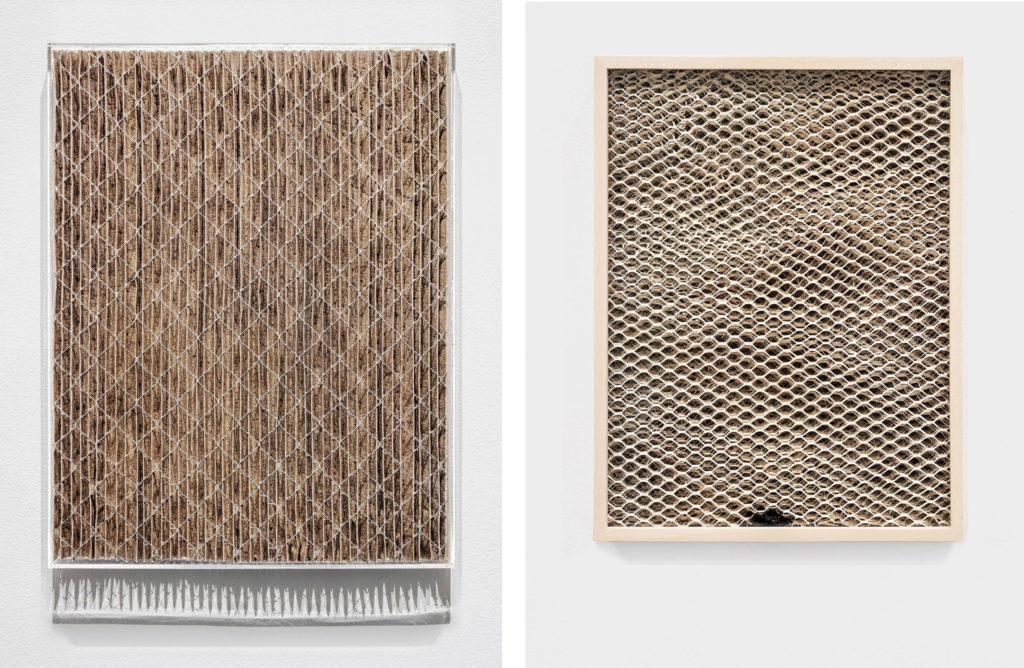 Left: Tegan Moore, Dust in the Heat, 2018. Used ventilation filter, clay dust, wood dust, other particulate matter and acrylic glass, 43.1 x33 cm. Right: Tegan Moore, We / liked / the feeling / of it, 2018. Humidifier filter (expanded aluminum, clay), soft maple and conservation glass, 33 x 25.4 cm. Courtesy the artist / Zalucky Contemporary.
Left: Tegan Moore, Dust in the Heat, 2018. Used ventilation filter, clay dust, wood dust, other particulate matter and acrylic glass, 43.1 x33 cm. Right: Tegan Moore, We / liked / the feeling / of it, 2018. Humidifier filter (expanded aluminum, clay), soft maple and conservation glass, 33 x 25.4 cm. Courtesy the artist / Zalucky Contemporary.
